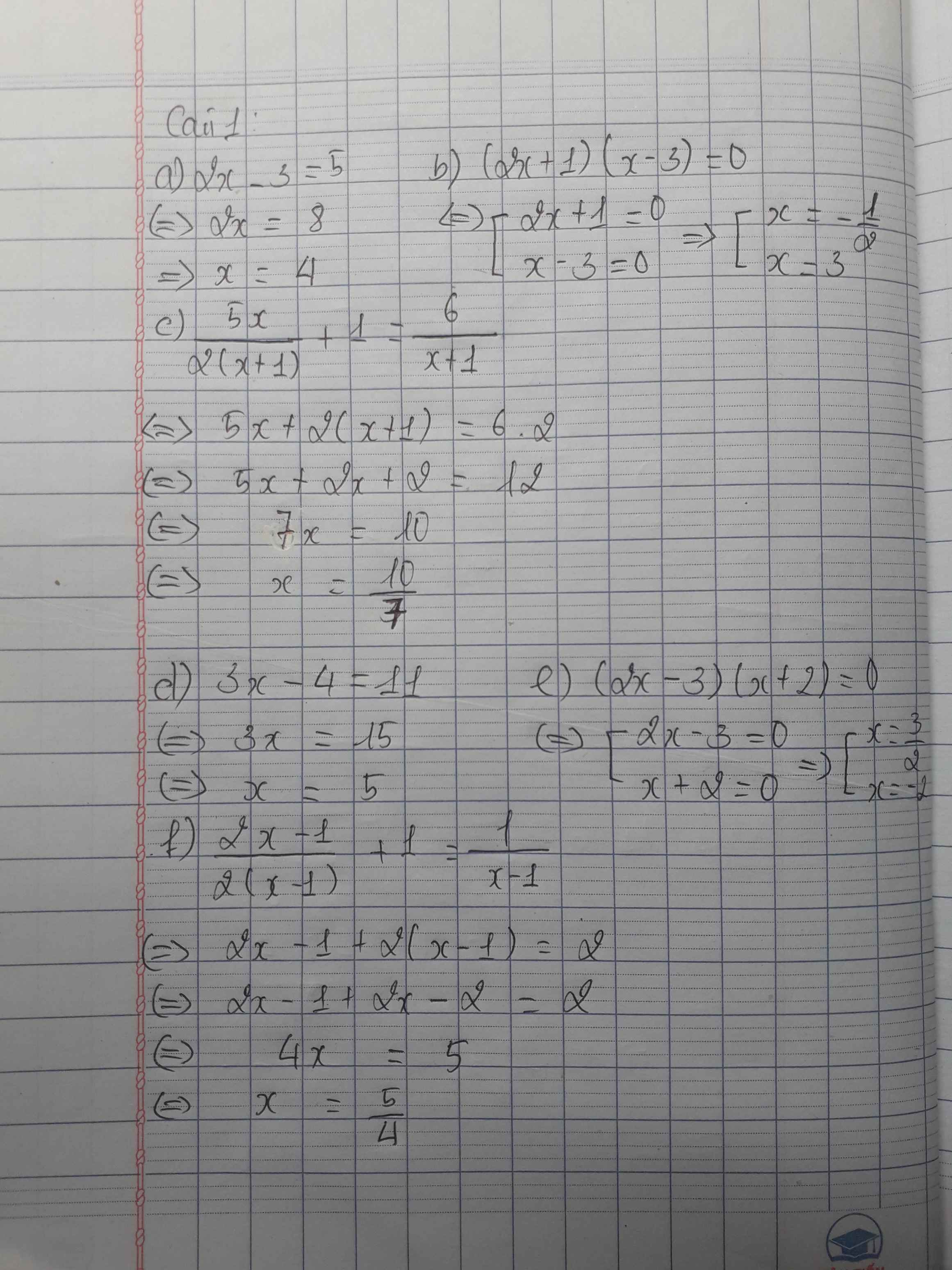1:Giải phương trình( giải chi tiết giúp mình với ạ)
Hãy nhập câu hỏi của bạn vào đây, nếu là tài khoản VIP, bạn sẽ được ưu tiên trả lời.

ĐKXĐ: \(0\le x\le9\)
Bình phương 2 vế ta được:
\(x+9-x+2\sqrt{x\left(9-x\right)}=-x^2+9x+9\)
\(\Leftrightarrow-x^2+9x-2\sqrt{-x^2+9x}=0\)
\(\Leftrightarrow\sqrt{-x^2+9x}\left(\sqrt{-x^2+9x}-2\right)=0\)
\(\Leftrightarrow\left[{}\begin{matrix}\sqrt{-x^2+9x}=0\\\sqrt{-x^2+9x}=2\end{matrix}\right.\)
\(\Leftrightarrow\left[{}\begin{matrix}-x^2+9x=0\\-x^2+9x-4=0\end{matrix}\right.\)
Tới đây em tự hoàn thành nốt

Bài 1:
ĐKXĐ: \(x\ge\dfrac{1}{2}\)
Ta có: \(\sqrt{5x^2}=2x-1\)
\(\Leftrightarrow5x^2=\left(2x-1\right)^2\)
\(\Leftrightarrow5x^2-4x^2+4x-1=0\)
\(\Leftrightarrow x^2+4x-1=0\)
\(\text{Δ}=4^2-4\cdot1\cdot\left(-1\right)=20\)
Vì Δ>0 nên phương trình có hai nghiệm phân biệt là:
\(\left\{{}\begin{matrix}x_1=\dfrac{-4-2\sqrt{5}}{2}=-2-\sqrt{5}\left(loại\right)\\x_2=\dfrac{-4+2\sqrt{5}}{2}=-2+\sqrt{5}\left(loại\right)\end{matrix}\right.\)
Bài 1: Bình phương hai vế lên có giải ra được kết quả. Nhưng phải kèm thêm điều kiện $2x-1\geq 0$ do $\sqrt{5x^2}\geq 0$
PT \(\Leftrightarrow \left\{\begin{matrix} 2x-1\geq 0\\ 5x^2=(2x-1)^2\end{matrix}\right.\Leftrightarrow \left\{\begin{matrix} x\geq \frac{1}{2}\\ x^2+4x-1=0\end{matrix}\right.\)
\(\Leftrightarrow \left\{\begin{matrix} x\geq \frac{1}{2}\\ (x+2)^2-5=0\end{matrix}\right.\Leftrightarrow \left\{\begin{matrix} x\geq \frac{1}{2}\\ (x+2-\sqrt{5})(x+2+\sqrt{5})=0\end{matrix}\right.\)
\(\Leftrightarrow \left\{\begin{matrix} x\geq \frac{1}{2}\\ x=-2\pm \sqrt{5}\end{matrix}\right.\) (vô lý)
Vậy pt vô nghiệm.

ĐK: \(x\ge0\)
Dễ thấy \(1-\sqrt{2\left(x^2-x+1\right)}\le1-\sqrt{2}< 0\)
Khi đó bất phương trình tương đương:
\(x-\sqrt{x}\le1-\sqrt{2\left(x^2-x+1\right)}\)
\(\Leftrightarrow\sqrt{x}-\dfrac{1}{\sqrt{x}}-1+\sqrt{2\left(x+\dfrac{1}{x}-1\right)}\le0\)
\(\Leftrightarrow\sqrt{x}-\dfrac{1}{\sqrt{x}}-1+\sqrt{2\left(\sqrt{x}-\dfrac{1}{\sqrt{x}}\right)^2+2}\le0\)
\(\Leftrightarrow t-1+\sqrt{2t^2+2}\le0\)

ĐKXĐ: \(x\ge1\)
Đặt \(\left\{{}\begin{matrix}\sqrt[]{x-1}=a\ge0\\\sqrt[3]{2-x}=b\end{matrix}\right.\) \(\Rightarrow a^2+b^3=1\)
Ta được hệ:
\(\left\{{}\begin{matrix}a+b=1\\a^2+b^3=1\end{matrix}\right.\) \(\Leftrightarrow\left\{{}\begin{matrix}b=1-a\\a^2+b^3=1\end{matrix}\right.\)
\(\Rightarrow a^2+\left(1-a\right)^3=1\)
\(\Leftrightarrow a^3-4a^2+3a=0\)
\(\Leftrightarrow a\left(a-1\right)\left(a-3\right)=0\)
\(\Rightarrow\left[{}\begin{matrix}a=0\\a=1\\a=3\end{matrix}\right.\) \(\Rightarrow\left[{}\begin{matrix}\sqrt[]{x-1}=0\\\sqrt[]{x-1}=1\\\sqrt[]{x-1}=3\end{matrix}\right.\)
\(\Rightarrow\left[{}\begin{matrix}x=1\\x=2\\x=10\end{matrix}\right.\)

Câu 1:
a)2x-3=5
\(\leftrightarrow\)2x=5+3
\(\leftrightarrow\)2x=8
\(\leftrightarrow\)x=4
Vậy pt có tập nghiệm S={4}
b)(2x+1)(x-3)=0
\(\leftrightarrow\) 2x+1=0
Hoặc x-3=0
\(\leftrightarrow\)x=-1/2
x=3
Vậy pt có tập nghiệm S={-1/2;3}
d)3x-4=11
\(\leftrightarrow\)3x=11+4
\(\leftrightarrow\)3x=15
\(\leftrightarrow\)x=5
Vậy pt có tập nghiệm S={5}
e)(2x-3)(x+2)=0
\(\leftrightarrow\)2x-3=0
Hoặc x+2=0
\(\leftrightarrow\)x=3/2
hoặc x=-2
Vậy pt có tập nghiệm S={3/2;-2}
Câu 2:
a)2x-3<15
\(\leftrightarrow\)2x<15+3
\(\leftrightarrow\)2x<18
\(\leftrightarrow\)x<9
Vật bpt có tập nghiệm S={x|x<9}
c)5x-2<18
\(\leftrightarrow\)5x<20
\(\leftrightarrow\)x<4
Vậy bpt có tập nghiệm S={x|x<4}
Mấy bài phân số nhác gõ quá~

Ta có:
(2 - 3x)(x + 8) = (3x - 2)(3 - 5x)
⇔ (2 - 3x)(x + 8) - (3x - 2)(3 - 5x) = 0
⇔ (2 - 3x)(x + 8) + (2 - 3x)(3 - 5x) = 0
⇔ (2 - 3x)(x + 8 + 3 - 5x) = 0
⇔ (2 - 3x)(11 - 4x) = 0
⇔ 2 - 3x = 0 hay 11 - 4x = 0
⇔ 2 = 3x hay 11 = 4x
⇔ x = \(\dfrac{2}{3}\) hay x = \(\dfrac{11}{4}\)
Vậy tập nghiệm của pt S = \(\left\{\dfrac{2}{3};\dfrac{11}{4}\right\}\)
<=> (2-3x ) (x+8) + (2-3x ) (3-5x)=0
<=> (2-3x ) ( x+8 + 3-5x ) =0
<=> (2-3x ) ( 11 - 4x ) = 0
=> 2-3x =0 hoặc 11-4x =0
3x = 2 4x =11
x = 2/3 x = 11/4


gọi x là vận tốc của ô tô
y là vận tốc của xe máy (km/h) (x>y>0)
sau 4h 2 xe gặp nhau nên tổng quãng đường AB bằng:
AB= 4.x+4.y = 4.(x+y) (km)
nên thgian ô tô và xe máy đi hết AB lần lượt là:
\(\dfrac{4\left(x+y\right)}{y}\)(h); \(\dfrac{4\left(x+y\right)}{x}\) (h)
vì ô tô đến sớm hơn xe máy 6h nên ta có pt:
\(\dfrac{4\left(x+y\right)}{y}\)-\(\dfrac{4\left(x+y\right)}{x}\)=6
⇔\(\dfrac{4x+4y}{y}\)-\(\dfrac{4x+4y}{x}\)=6
⇔4.\(\dfrac{x}{y}\) +4-4-\(\dfrac{4y}{x}\)=6
⇔\(\dfrac{x}{y}\)-\(\dfrac{y}{x}\)=\(\dfrac{6}{4}\)=\(\dfrac{3}{2}\)
đặt: t=\(\dfrac{x}{y}\) (t>0)
⇒t-\(\dfrac{1}{t}\)=\(\dfrac{3}{2}\)
⇔t2-\(\dfrac{3}{2}\)t-1=0
⇔(t -2)(t +\(\dfrac{1}{2}\))=0
⇔t=2
⇒\(\dfrac{x}{y}\)=2 ⇒x=2y
⇒AB=4.(x+y)=6x=12y
nên thgian ô tô và xe máy đi hết AB lần lượt là:
\(\dfrac{6x}{x}=6\) (h)\(\dfrac{12y}{y}=12\) (h)
Gọi thời gian xe máy đi hết quãng đường AB là x (h) (x>4)
thời gian xe máy đi hết quãng đường AB là y (h) (y>4)
Trong 1 giờ xe máy đi được \(\dfrac{1}{x}\) (quãng đường)
Trong 1 giờ ô tô đi được \(\dfrac{1}{y}\) (quãng đường)
Trong 1 giờ hai xe đi được \(\dfrac{1}{x}+\dfrac{1}{y}=\dfrac{1}{4}\left(1\right)\)
Mà thời gian ô tô về đến A sớm hơn xe máy về đến B là 6 giờ nên: \(x-y=6\left(2\right)\)
Từ (1) và (2) ta có hệ phương trình:
\(\left\{{}\begin{matrix}\dfrac{1}{x}+\dfrac{1}{y}=\dfrac{1}{4}\\x-y=6\end{matrix}\right.\) \(\Leftrightarrow\left\{{}\begin{matrix}\dfrac{1}{x}+\dfrac{1}{x-6}=\dfrac{1}{4}\\y=x-6\end{matrix}\right.\)
\(\Leftrightarrow\left\{{}\begin{matrix}x^2-14x+24=0\\y=2-6\end{matrix}\right.\)(ĐK:\(x\ne6\)) \(\Leftrightarrow\left\{{}\begin{matrix}x=12\\y=6\end{matrix}\right.\)(TM)
Vậy thời gian xe máy đi hết quãng đường AB là 12 giờ
thời gian ô tô đi hết quãng đường AB là 6giờ
-Chúc bạn học tốt-





a. \(\sqrt{4x}+\sqrt{x}=2\Leftrightarrow2\sqrt{x}+\sqrt{x}=2\Leftrightarrow3\sqrt{x}=2\Leftrightarrow\sqrt{x}=\frac{2}{3}\Leftrightarrow x=\frac{4}{9}\)
b. \(\sqrt{x^2-4}=\sqrt{x-2}\Leftrightarrow\hept{\begin{cases}x^2-4=x-2\\x-2\ge0\end{cases}}\Leftrightarrow\hept{\begin{cases}\orbr{\begin{cases}x=2\\x=-1\end{cases}}\\x\ge2\end{cases}}\Leftrightarrow x=2\)\(\sqrt{x^2-4}=\sqrt{x-2}\Leftrightarrow\hept{\begin{cases}x^2-4=x-2\\x-2\ge2\end{cases}}\Leftrightarrow\hept{\begin{cases}\left(x-2\right)\left(x+1\right)=0\\x\ge2\end{cases}}\Leftrightarrow x=2\)
c.\(\sqrt{x^2-2x}+\sqrt{2x^2+4x}=2x\Leftrightarrow\hept{\begin{cases}x\ge0\\x^2-2x+2x^2+4x+2\sqrt{x^2-2x}.\sqrt{2x^2+4x}=4x^2\end{cases}}\)
\(\Rightarrow x^2-2x=2\sqrt{x^2-2x}.\sqrt{2x^2+4x}\Leftrightarrow\orbr{\begin{cases}\sqrt{x^2-2x}=0\\\sqrt{x^2-2x}=2\sqrt{2x^2+4x}\end{cases}}\)
\(\Leftrightarrow\orbr{\begin{cases}x=0\text{ hoặc }x=2\\x^2-2x=8x^2+16x\end{cases}\Leftrightarrow}\)hoặc x=0 hoặc x=2 hoặc x= -18/7
Kết hợp điều kiện ta có : \(x=0\text{ hoặc }x=2\)
d. Điều kiện \(x\ge3\) ta có :
\(\sqrt{x^2+2x-15}=\sqrt{x-3}+\sqrt{x^2-3x}\Leftrightarrow x^2+2x-15=x^2-2x-3+2\sqrt{x-3}\sqrt{x^2-3x}\)
\(\Leftrightarrow2x-6=\sqrt{x-3}.\sqrt{x^2-3x}\Leftrightarrow4\left(x-3\right)^2=\left(x-3\right)\left(x^2-3x\right)\Leftrightarrow\orbr{\begin{cases}x=3\\x=4\end{cases}}\)